
Untitled (1968)
Craig Kauffman
An example of Craig Kauffman’s best-known series of works, this untitled “bubble” sculpture is made of vacuum-formed plastic. Kauffman was one of the earliest adopters of industrial plastics as a fine art material, led there by an interest in creating shapes that were "their own supports." Kauffman's technical virtuosity is demonstrated by the simultaneous transparency, translucency, and reflectivity visible in this piece, as well as its lush and subtle pigmentation.
Synthetic polymer vaccum-formed Plexiglas with acrylic lacquer 23 x 61 x 12 in
Collection Museum of Contemporary Art San Diego, Gift of Arthur and Carol Goldberg in honor of Margo Leavin © 1968 Estate of Craig Kauffman. Photograph by Philipp Scholz Rittermann

Orange Wedge (1970)
Peter Alexander
Peter Alexander’s early experience building models in an architecture studio informed his later work as a visual artist. Using resin as a light-responsive material, Alexander creates precise forms in luscious colors and textures. This slender orange column is densely pigmented at the bottom and pales, almost to the point of disappearance, as it tapers to the top.
Acrylic 95 1/2 x 4 x 4 in
Collection Museum of Contemporary Art San Diego, Museum Purchase © 1970 Peter Alexander, Photograph by Philipp Scholz Rittermann
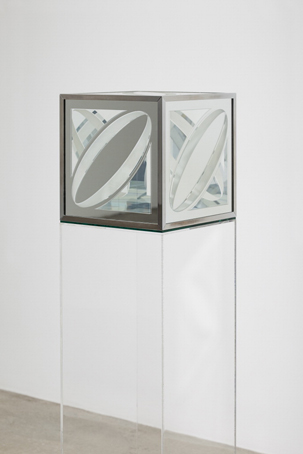
Untitled (1964)
Larry Bell
Larry Bell’s signature glass cube sculptures sprang from his optical manipulations of 3-D isometric projections on flat canvases. Bell’s leap from “making illusions of volumes to making volumes,” and his use of modular elliptical internal divisions, culminate in optically ambiguous three-dimensional objects, which are simultaneously discrete and site-responsive.
Coated glass with chrome-plated brass frame 14 1/4 x 14 1/4 x 14 1/2 in
Collection Museum of Contemporary Art San Diego, Museum Purchase © 1964 Larry Bell, Photograph by Philipp Scholz Rittermann
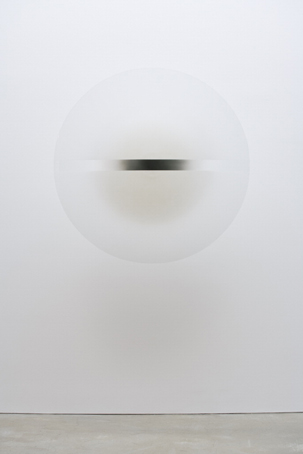
Untitled (1969)
Robert Irwin
This disc represents Robert Irwin’s transition away from painting and toward more experimental investigations of light, space, and perceptual investigation. Irwin’s acrylic discs present a visual conundrum, simultaneously dissolving into the wall yet projecting out and casting shadows. Part of a series, this work is an almost invisible convex acrylic form bisected in the center by a gray line, which anchors it visually in space. This disappearance of the art object and the active engagement with the architectural surround was developed more fully by Irwin in his subsequent installations involving scrim.
Acrylic lacquer on formed acrylic plastic Diameter: 53 in., depth: 3 in
Collection Museum of Contemporary Art San Diego, Museum Purchase © Robert Irwin / Artists Rights Society (ARS), New York. Photograph by Philipp Scholz Rittermann
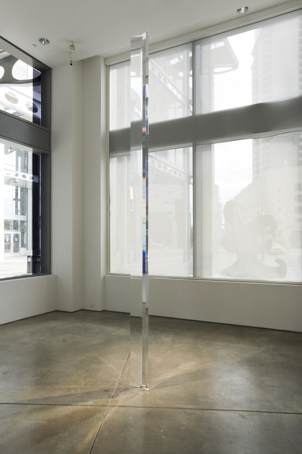
Untitled (1969-70)
Robert Irwin
Robert Irwin’s cast acrylic column is one of the last object-based works he made before focusing on site-conditioned installations. The twelve-foot-tall sculpture functions as a prism, reflecting and refracting light. in spite of its towering height, from certain angles the work is almost invisible.
Cast acrylic column 144 x 8 1/2 x 3 1/2 in
Collection Museum of Contemporary Art San Diego, Museum Purchase in Honor of Jackie and Rea Axline © Robert Irwin / Artists Rights Society (ARS), New York. Photograph by Philipp Scholz Rittermann
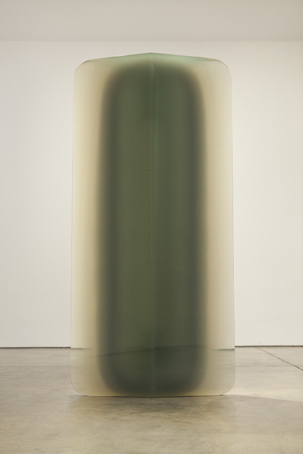
Diamond Column (1978)
De Wain Valentine
Diamond Column is a resin solid with an acute diamond footprint. Shimmering pigments embedded in the sculpture shade from clear to bronze at the edges, while a blue-green-lavender form seems to float in the center of the piece. Depending on one's viewpoint, the work may appear to have sharp or round edges, be transparent or translucent, appear hazy or create sharply focused prismatic effects. A prime example of how cast resin can pull in light and refract it back out again, this chameleonlike work demonstrates the ambiguity and contingency at the heart of phenomenological experience.
Polyester resin 91 1/2 x 44 x 12 in
Collection Museum of Contemporary Art San Diego, Museum Purchase © 1978 De Wain Valentine. Photograph by Philipp Scholz Rittermann
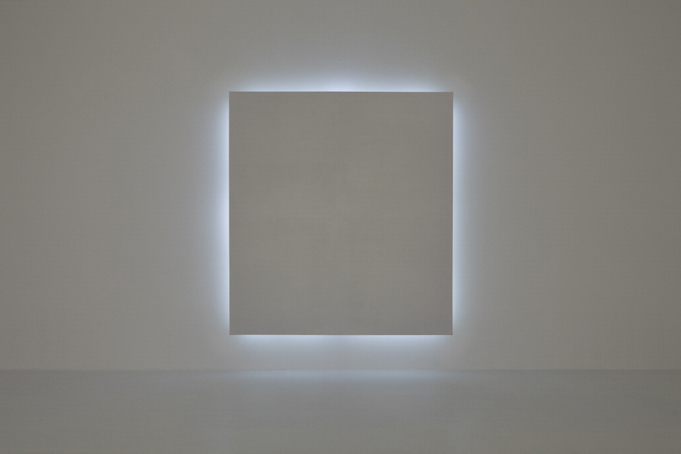
Untitled (1965)
Doug Wheeler
This essentially monochrome canvas was subtly sprayed with light washes of acrylic pigment and mounted on a reverse-bevel frame embedded with neon light. The potential of light as a medium and perception as a primary focus in his art is catalyzed in this formative piece, after which Wheeler abandoned painting and worked directly with light, plastics, and the architectural surround.
Acrylic on canvas with neon tubing 87 5/8 x 80 3/4 x 4 in
Collection Museum of Contemporary Art San Diego, Gift of the artist and partial Museum purchase with International and Contemporary Collectors Funds and proceeds from the Museum of Contemporary Art San Diego Art Auction 2010 © 1965 Doug Wheeler. Photograph by Philipp Scholz Rittermann

Untitled (1968-69)
Helen Pashgian
Beginning in the early 1960s, Helen Pashgian worked with resin to create discs, spheres, and flat works that convey a mysterious sense of depth. This untitled sphere reveals the exquisite palette and subtle play with light that Pashgian was able to achieve through experimentation—trial and error with a new and previously untested material.
Cast polyester resin Diameter: 8 in
Courtesy of the artist © 1968–1969 Helen Pashgian. Photograph by Philipp Scholz Rittermann
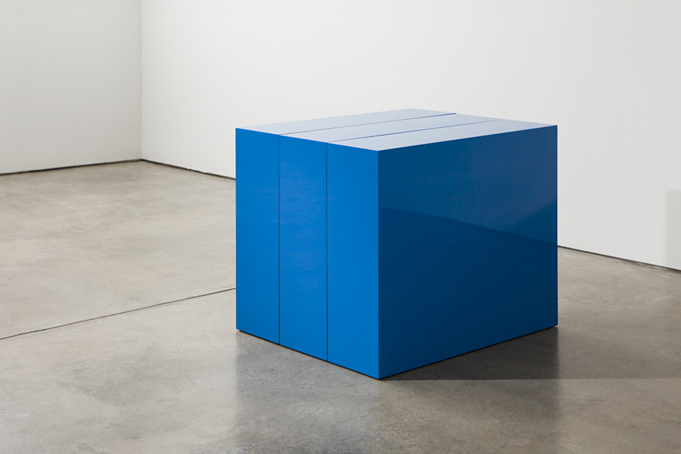
Blue Block in Three Parts (1966)
John McCracken
John McCracken is best known for geometric sculptures including cubes, pyramids, and "planks" (tall slender objects that lean against the wall), which are finished with polyester resin, fiberglass, and/or lacquer. A work such as Blue Block in Three Parts appears from some angles as a bold, solid form, while from other points of view its polished surface reflects its surroundings, making it seem less of a solid object. On this topic McCracken said, "I have always considered that my work primarily uses form to speak with. At the same time you have to make form out of something and so I use color. And, since I want sensuousness, and touchability—mentally speaking—in my work, I also use the polished surface. The polished surfaces (I don't know if I knew this when I first used them) give a seeming transparency and illusoriness, a not-thereness, to the work."
Lacquer, polyester resin, fiberglass, plywood 33 x 40 x 33 in
Collection Museum of Contemporary Art San Diego. Museum purchase with funds from Ansley I. Graham Trust, Los Angeles ©1966 John McCracken. Courtesy of David Zwirner, New York. Photograph by Philipp Scholz Rittermann

#54 July/August 2nd Level Density (1968)
Ron Cooper
Ron Cooper describes this resin and fiberglass piece as a “light entrapment,” because it is designed to bounce light between its front and back surfaces. The work is built up from many thin layers of clear and pigmented resin. The overall color of this work is pale gold modulated with soft pink and green highlights. The surface has a granular shimmer, like salt or sand capturing light.
Polyester resin, fiberglass, and pigment 86 ¼ x 86 ¼ x 3 5/8 in
Collection Museum of Contemporary Art San Diego, Gift of Mr. and Mrs. Stanley Grinstein © 2010 Ron Cooper/Artists Rights Society (ARS), New York. Photograph by Philipp Scholz Rittermann
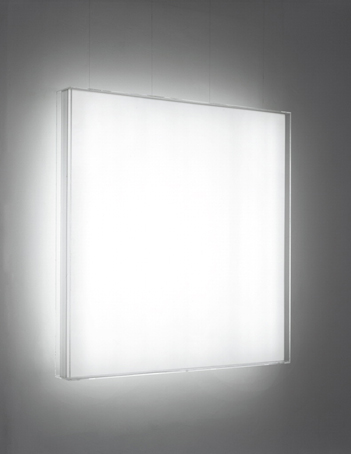
Untitled (Space + Electric Light) (1968)
Mary Corse
Untitled (Space + Electric Light) is an elegant yet slightly menacing work exploring the psychological effects of industrial light. Suspended from the ceiling by imperceptible minofilaments, the work appears to float as it literally hums with energy provided by the Tesla coils that power the light-emitting neon tubes encased in nesting Plexiglas boxes.
Plexiglas, neon, high frequency energy 45 x 45 x 4 1/2 in
Collection Museum of Contemporary Art San Diego, Museum purchase with funds from the Annenberg Foundation. Courtesy of the artist and Ace Gallery © 1968 Mary Corse, Photograph courtesy of the artist and Ace Gallery
























